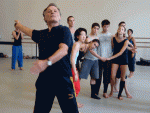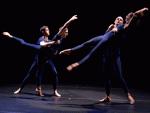Title
Speaking with Lar Lubovitch (’64, dance), one can’t miss that, while he remains a prolific creator of new works that speak to the here and now, he also happily reflects on the myriad of experiences that have resulted in this year’s historic celebration of the Lar Lubovitch Dance Company’s 40th anniversary season. Lubovitch, 65, does not shy away from his past, as evidenced in the plans for the season. “I wanted to honor all the particular episodes in my life,” he said. “My work honors my history … the story from which I’ve emerged.”
Lar Lubovitch rehearsing Juilliard dancers at the School in September, in preparation for their performance with his company at Dance Theater Workshop in October.
(Photo by Jane Rubinsky)Body
Born in Chicago, young Lar and his siblings often put on little shows. “I choreographed not knowing I was choreographing,” he told Norma McLain Stoop in a 1972 Dance Magazine article. “I had no steps, no vocabulary, but it had great meaning to me, these shiftings of bodies through space.” Nurturing his creativity with a major in studio art at the University of Iowa, Lubovitch was first exposed to modern dance with a performance there by the José Limón Dance Company. That initiation into the world of dance led him to Juilliard.
Juilliard was a watershed period for Lubovitch, where his life, as he described it in a recent interview, “turned and changed for the way it was intended. The world of ideas opened to me.” Of his time at the School, Lubovitch says he doesn’t recall a specific moment of important artistic or personal insight, but a constant layering of new ideas about movement, technique, musicality, and choreography from “powerful teachers who were very important dancers of their time.” Antony Tudor, Anna Sokolow, Louis Horst, Martha Graham, and José Limón—in their own ways, all were potent mentors. “Tudor greatly influenced my relationship to music,” observes Lubovitch. “In his own work, he had a way of poeticizing music; it wasn’t an illustration of music, but an additional visual line,” he explains, “much the way the voice of opera creates texture on its own.”
This intuitive approach to musical interpretation, in which the movement is the equivalent of another musical line, is evident in Lubovitch’s body of choreographic work. The International Dictionary of Modern Dance describes Lubovitch as “one of modern dance’s most eclectic emissaries,” a statement reflective of the scope of his works, which span modern dance, Broadway, and ice dancing. Lubovitch used his time at Juilliard as an opportunity to immerse himself in all types of movement, knowing that he had to become a dancer conversant in a range of movement styles before he could choreograph. It was during his tenure as member of the Harkness Ballet—which he joined for two years in the mid-’60s, after Juilliard and further study at the Joffrey Ballet School and the Martha Graham School—that his desire to be a choreographer crystallized, as he gained the experience of “dancing a great deal of bad choreography,” as he put it. “We had superb dancers and a very bad repertory.” While immersed in this challenge, Lubovitch began developing choreography that was more conducive to a dancer’s physical understanding of movement. A symbiotic pairing of ballet and modern, he says that his vocabulary comes from “basic, gut-moving experience. My vocabulary is very broad and non-judgmental. I speak a sort of dance Esperanto.”
While bridging the gap between ballet and modern dance was instinctual for Lubovitch, the formation of his company has had an enormous impact on his movement development and choreography. “I believe I have evolved a way of making a dance, and that language is a motor upon which my dances move,” he says. “There is no question that having one’s own company can produce the greatest strides in developing your common language.” While his choreographic work on Broadway and in the world of ice dancing provided rejuvenating “excursions into expansion,” he notes, “they have no connective tissue to enhancing that vocabulary … that signature voice.”
In celebration of these past four decades, the 2008-09 season will take Lubovitch’s company on an ambitious tour, with two significant performances in New York City this fall. In honor of the American Dance Festival’s 75th anniversary, the company performed a tour preview at the festival in Durham, N.C., in June, followed by the official premiere engagement for the national tour at Jacob’s Pillow in July. Juilliard is prominent throughout the 40th anniversary, with alumni Jonathan Alsberry, Jay Franke, Brian McGinnis, Kate Skarpetowska and Chris Vo performing as members of the Lar Lubovitch Dance Company, and a group of current students featured in the company’s performances in New York.
As a part of this historic season, Lubovitch wanted to honor his time at Juilliard by inviting 13 current Juilliard dance students to perform Whirligogs and North Star, works created during his minimalist movement phase from 1975 to the early ’80s. Lubovitch thought these works, representing a key part of his 40-year-long journey, were best shown off by young dancers. The Juilliard students first performed North Star at Dance Theater Workshop last month. “The idea at Dance Theater Workshop was to look back at a pivotal period, not only for my company, but a seminal moment in dance,” Lubovitch explains. They will also perform the works at New York City Center—the theater whose recent revival as a hub for what is new and exciting in the dance world makes it the perfect setting for the company’s main New York season. This month, from November 5 through 8, the Lar Lubovitch Dance Company will premiere the first full production of Jangle, a new piece, as well as other historic works choreographed by Lubovitch throughout the company’s four decades.
In addition to celebrating in New York City, the company joined a dozen leading dance companies appearing at the Chicago Dancing Festival, an exciting new festival launched in 2007 by Lubovitch and another Chicago-born Juilliard alumnus, Jay Franke, in cooperation with Chicago’s Museum of Contemporary Art and the City of Chicago. The festival is a component of Chicago Dancing Company, a nonprofit whose mission is to broaden the scope of the Chicago dance scene, increase accessibility to the art form, and produce and promote the finest dance in Chicago. The Lar Lubovitch Dance Company will also tour to more than 20 cities across the United States through February 2009.
Lubovitch has choreographed more than 100 dances for his New York-based company. While he has been hailed by one New York Times critic as “one of the 10 best choreographers in the world,” his choreography has sometimes come under fire for a musicality and lyricism that are too obvious and accessible, and has been characterized as unabashedly entertaining while lacking in substance. Reflecting on his work, Lubovitch is proud of his ability to “make music visible. I would take no pride in making work that is difficult to understand.” Putting the music at the forefront of the process, he considers his musicality to be about “creating an image of the music in its essence. I hope to always embody the music.”
Asked what impact he thought his company has had on the world of modern dance, Lubovitch is unable to assess his place in the dance spectrum, as his focus is “towards the work, and not the effect.” He sees his work over the past four decades as “an individual journey—as my own desire to keep challenging myself.”
As for the future, Lubovitch will let the art be his guide. “I see as clearly as I can the next dance I want to make—that is as far forward as I want to focus,” he says. “My work is about many things, I think, in equal portion; it is about dancing itself. That is the bottom-line motivating force that causes it to be created. Seeing people dance and creating vehicles for that. It is dance itself that is my deepest love.”






